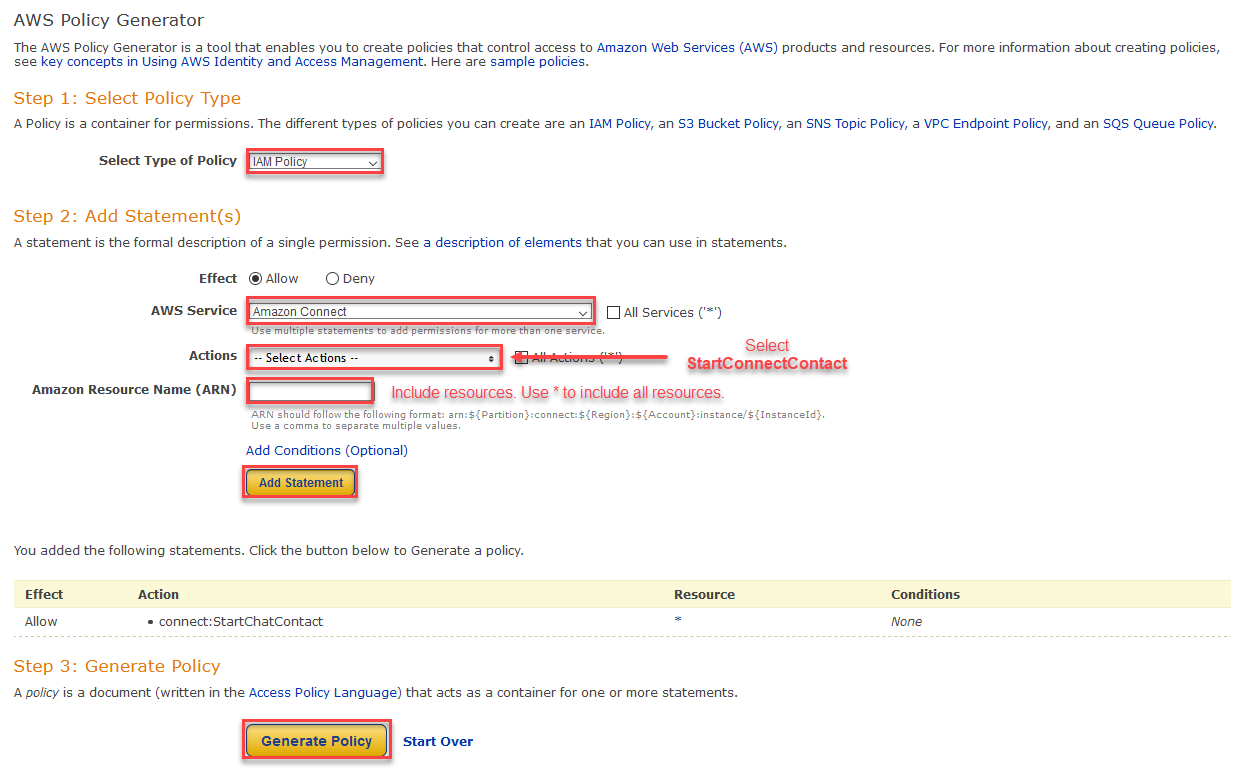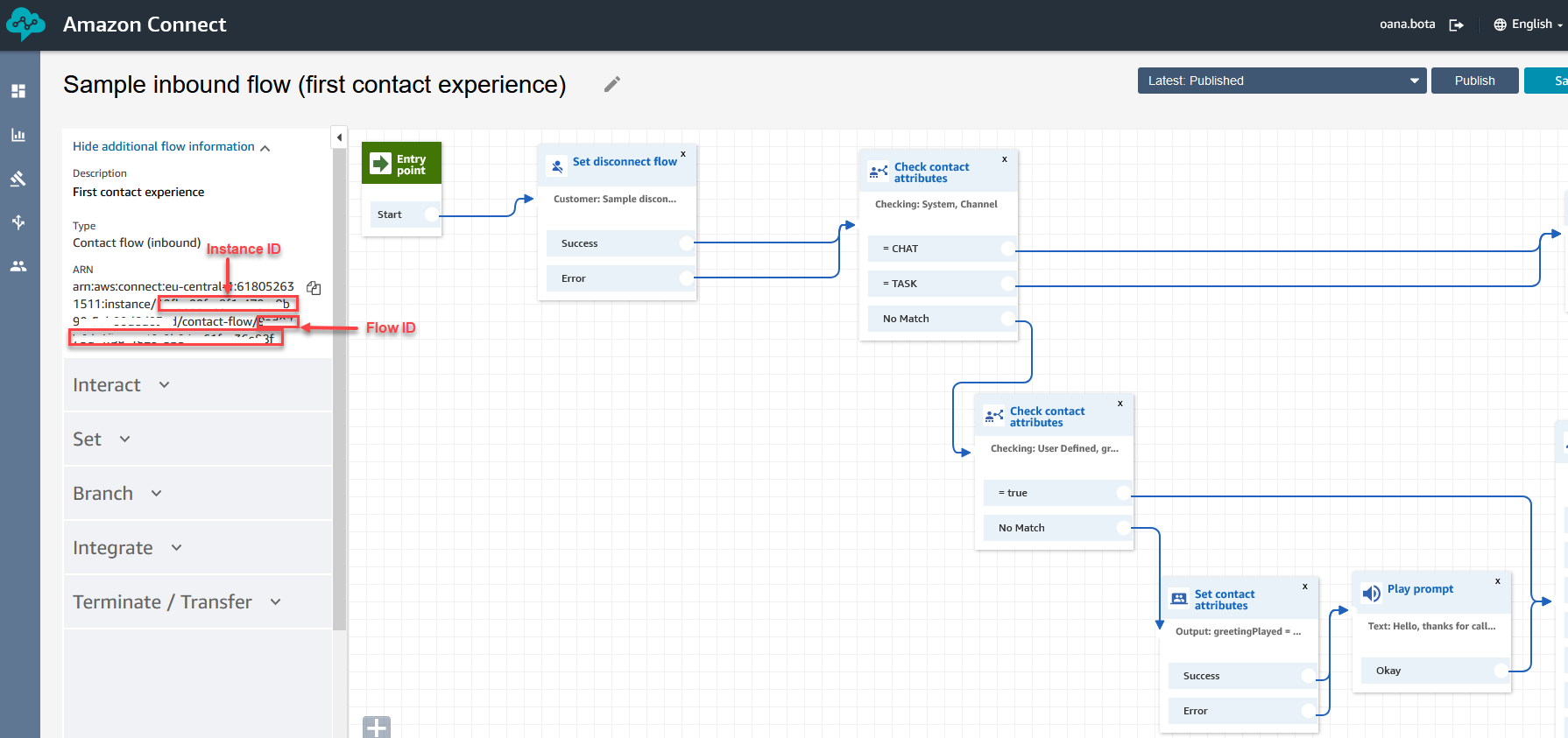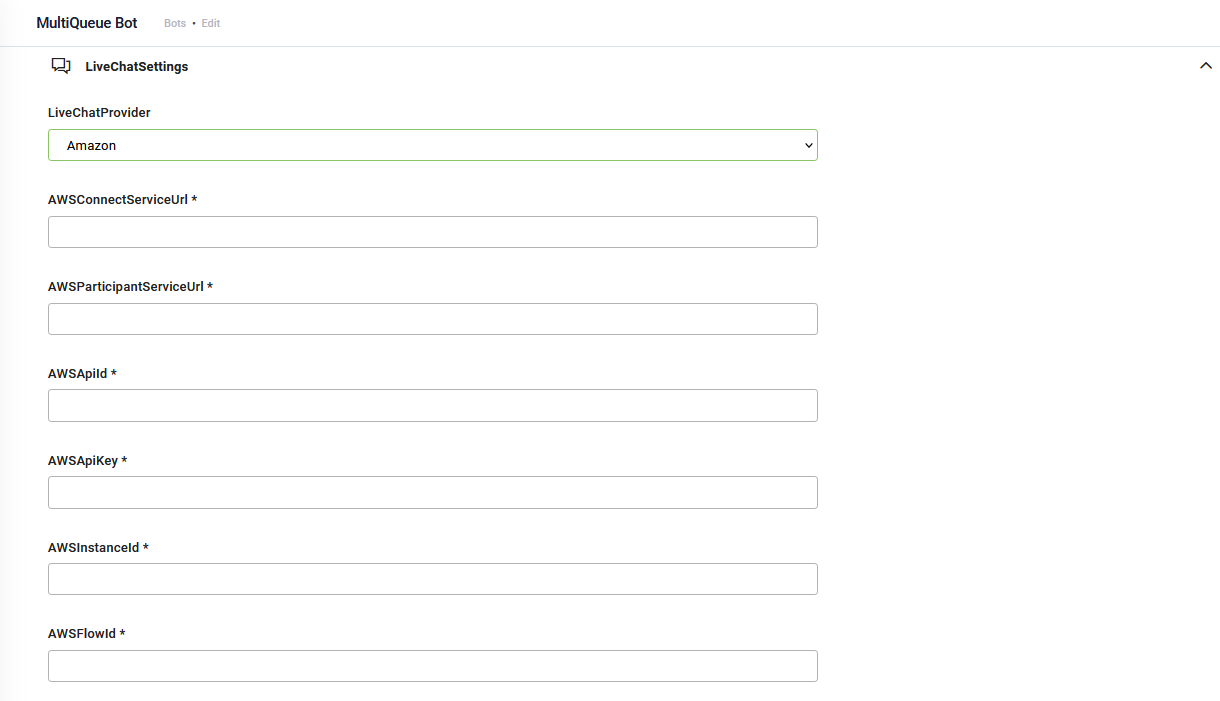Amazon Live Chat Integration
You can now integrate Amazon Connect with Druid to allow your customers chat with the bot and get support from your Contact Center agents who are using Amazon Connect.
Prerequisites
- You need to have the call center set up in Amazon Connect.
- You need an Amazon Console account.
Configuring the integration
This section provides the steps necessary to place a customer live chat in Amazon Connect (that is, start an Amazon live chat session).
Step 1: Create AWS user dedicated for the Amazon Connect - Druid Integration
- Log in the AWS Management Console and go to Identity Access Management (IAM).
- Create a DRUID-dedicated IAM user and assign an IAM policy that grants access to the Amazon Connect service and the following actions:
- StartChatContact
- StopContact
- You can provide specific flow access in the Policy Editor as per examples below.
- On the user details page, click the Security credentials tab and generate access key for this user by clicking the Create access key button. When the access key is created, the Access key ID displays in the table and you also get the secret key.
- Write down or copy / paste in a document the Access key ID and secret key, you will need them later to configure your DRUID bot for Amazon Connect integration.
If you want to pass the client’s position in the queue to Druid, also grant access to: GetContactMetrics.
Example of IAM Policy which grants user access to all Amazon Connect resources:
{
"Version": "2012-10-17",
"Statement": [
{
"Action": [
"connect:StartChatContact",
"connect:StopContact",
"connect:GetContactMetrics"
],
"Resource": ["*"],
"Effect": "Allow"
}
]
}Example of IAM Policy which grants user access to specific Amazon Connect resources:
You can use the AWS Policy Generator to generate the policy.
Step 2: Get Amazon Connect Instance ID and Flow ID
In Amazon Connect, go to the details page of the flow you want to trigger from DRUID. On the flow menu, click Show additional flow information. From the ARN section, copy the Instance ID and the flow Id and paste them in a document, you will need these IDs to configure your Druid bot for Amazon Connect integration.
Step 3: Configure DRUID for Amazon Connect
Go to bot details page and click the LiveChatSettings section header. The section expands.
Set the Amazon Live Chat fields as described in the table below
| Field | Description |
|---|---|
| LiveChatProvider | Select Amazon. |
| AWSConnectServiceUrl |
Enter your Amazon Connect endpoint in the following format: https://connect.[REGION].amazonaws.com For the complete list of Amazon regions, see Amazon Connect documentation. Example: https://connect.eu-central-1.amazonaws.com for region eu-central-1. |
| AWSParticipantServiceUrl |
Enter your Amazon Connect Participant Service endpoint in the following format: https://participant.connect.[REGION].amazonaws.com. For the complete list of Amazon regions, see Amazon Connect documentation. Example: https://participant.connect.eu-central-1.amazonaws.com for region eu-central-1. |
| AWSApiId | The Access key ID created for your DRUID dedicated user (the one from Step 1.) |
| AWSApiKey | The Access key secret provided to you when creating the access key for your DRUID dedicated user (the one from Step 1). |
| AWSInstanceId | Amazon Connect Instance ID (the one you got at Step 2). |
| AWSFlowId | The flow ID that will be triggered in Amazon Connect (the one you got at Step 2). |
After you set up the Amazon Live Chat fields, click the Save & Close button to save the settings.
Step 4: Configure the flow step for connecting to Amazon Agent
On the flow of choice, add a step dedicated to connecting clients to Amazon Connect. On the flow step set the following variables:
- [[Chatuser]].Name = [[HelpdeskClient]].FirstName
- [[ChatUser]].HelpdeskSubject = [[HelpdeskClient]].Subject
On the dedicated step, in the PreActions section, call the internal action ConnectToHelpdeskAgent.
Send the conversation transcript to Amazon Live Chat Agents
Most contact centers want their helpdesk agents to get the transcript of the conversation the client had with the bot prior to being engaged in a live chat session.
To save the conversation transcript and make it available for Amazon Live Chat agents, on the flow that connects the client with the agent, make the following settings:
- On the step where you call the internal action ConnectToHelpdeskAgent(Post Actions section), in the Pre Actions section, call the internal action GetConversationTranscript.
- On the ConnectToHelpdeskAgent internal action add the following:
- Save the step.
{
"SendConversationTranscript": true
}Enable real-time queue position retrieval from Amazon Connect
To include a waiting user’s real-time position from the Amazon Live Chat queue in the Druid conversation context, set the PositionInQueueSetByCC parameter to true in the ConnectToHelpdeskAgent internal action.
{
"PositionInQueueSetByCC": true,
"SendConversationTranscript": true
}Send Contact Center Parameters
The table below lists the Contact Center parameters bot authors can send to Amazon Live Chat.
| Parameter | Data Type | Description |
|---|---|---|
| firstName | String | The first name of the client. |
| lastName | String | The last name of the client. |
| question | String | The question asked by the client. |
| queueId | Long |
The ID of the queue to which the client will be assigned. NOTE: If you have multiple queues, this is the Id of the Amazon Live Chat queue to which the client will be assigned.
|
| contactId | Long | The contact ID of the client. |
| organizationId | Long | The client organization ID. |
To send Contact Center parameters Amazon Live Chat, on the ConnectToHelpdeskAgent internal action, provide the desired parameters inside the ContactCenterParameters object in JSON format.
{
"SendConversationTranscript":true,
"ContactCenterParameters":
{
"firstName":"[[Customer]].FirstName",
"lastName":"@lastName",
"question":"[[Customer]].Question",
"queueId":"[[Entity]].QueueId",
"contactId":"@contactId",
"organizationId":""
}
}





